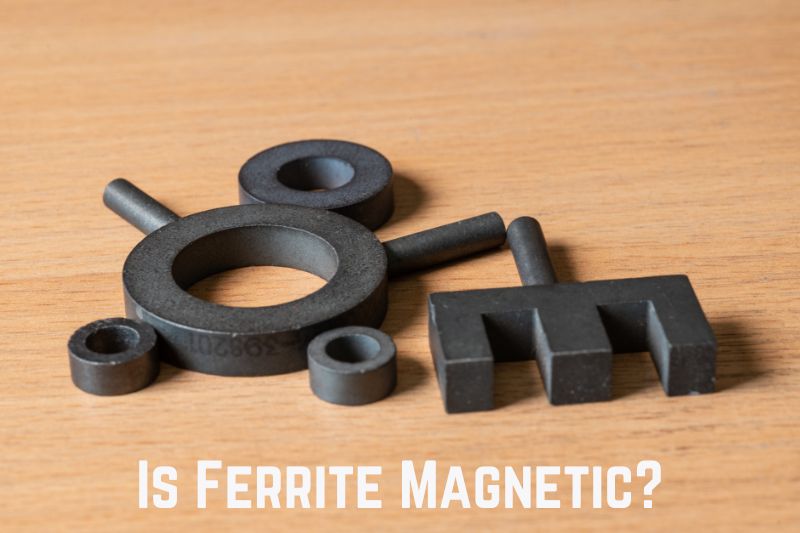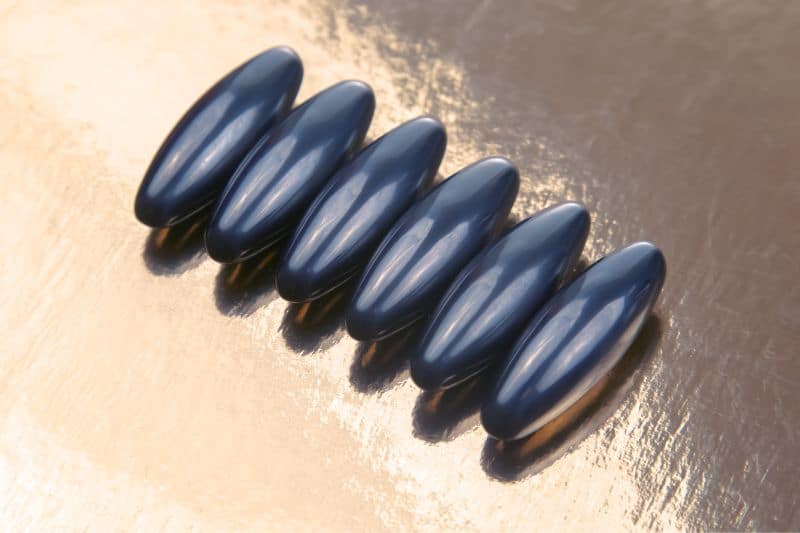Is Ferrite Magnetic? (Yes. It is)

Did you know that in 1930, two Japanese professors accidentally discovered the first chemical makeup of the ferrite magnets? Dr. Yogoro Kato and Dr. Takeshi Takei, based at the Tokyo Institute of Technology, made the discovery. However, it was in the 1950s that mass production of ferrite magnets began largely displacing earlier magnets in most industries. But what makes ferrite magnets unique? First, let’s address the question: Is ferrite magnetic?
Before answering that question in this article, we start by describing what ferrite is. We then proceed to explain if ferrite is ferromagnetic, conductive, its composition, and its structure. Finally, we highlight ferrite’s properties and uses.
Read: Is Sulfur Magnetic? (Answered)
What is Ferrite?
Ferrite is a non-metallic iron compound with magnetic properties. Iron oxide (rust) and other metals like nickel, manganese, copper, magnesium, cobalt, strontium, zinc, and barium are combined to form ferrites. Since the time of the Bible, magnetite, commonly referred to as lodestone (ferrous ferrite), has been the most well-known ferrite. In the electronics industry, ferrites are the most popular components.
Ferrite is divided into three types, as seen in the table below.
| Type of Ferrite | Characteristics |
| Soft ferrite | -A combination of iron plus soft metals, including nickel, zinc, and manganese. |
| -The material is known as soft ferrite because there is little to no residual magnetic field after the magnetizing magnetic field is no longer available. | |
| -Commonly used as a choke coil, or as the core of an intermediate frequency transformer, and other parts of machinery where the ability to reverse the magnetic field quickly is necessary. | |
| Hard (permanent) ferrites | -These are compounds of iron and other harder metals such as strontium and barium. |
| -Its residual magnetic field has a strong magnetic field after magnetization. It can sustain the residual magnetic field for a considerable amount of time. | |
| -Used in applications where permanent magnets are crucial, such as magnetic door latches. | |
| Semi-hard ferrite | -Composed of iron compounds mixed with cobalt. |
| -Has a strong saturation magnetostriction at 220 ppm. | |
| -Commonly used for actuators and sensors that use magnetostrictive technology. |
Watch this video to get a better understanding of Magnetostrictive technology from SICK | SICK AG
Is Ferrite Magnetic?
Yes, ferrite is magnetic. Also known as ceramic magnets, ferrites come in permanent and semi-permanent forms. Permanent ferrites have a strong magnetic field and can maintain their magnetization for extended periods, even in an opposing magnetic field.
Low-energy semi-permanent ferrites are needed to demagnetize ferromagnetic materials. Ferrites are the most common type of magnet produced worldwide.
Due to its high electrical insulating capabilities, hence the name ceramic magnets. A third name for ferrite magnets is feroba. Ferrite magnets are a low-cost magnet material that works well in large-scale manufacturing.
Neodymium, AlNico, and Ferrite are the three magnet types found in the universe. Ferrite magnets are the least powerful of the three and most durable. The strongest magnetic material is neodymium, although it corrodes quickly. Ferrites are resistant to heat, moisture, and rust. Unfortunately, despite having a high degree of heat and moisture resistance, AiNico magnets are quickly demagnetized.
Is Ferrite Ferromagnetic?
No, ferrite is not ferromagnetic. But It is ferrimagnetic. As a result, ferrite magnetizes to form permanent magnets by being attracted to a magnetic field. The magnetic moments of atoms in ferrite align in two or three different directions. The partial cancellation of the magnetic field eventually leaves a ferrite material with a weaker overall magnetic field.
Ferrite has a high magnetic permeability at high frequencies. In light of this, ferrite is a non-metallic magnetic material with many uses in the high-frequency sector.
In ferromagnetic materials, the magic moments all point in the same direction. In ferrimagnetic materials, the magnetic fields associated with individual atoms align themselves, some parallel or in the same direction, and others anti-parallel.
Like all ferrimagnetic materials, ferrite’s ferrimagnetism changes above its curie’s temperature. The ferrites attain paramagnetic properties.
Is Ferrite Conductive?
Ferrites are not conductive. They are chemical compounds with valence forces holding the electrons in place. Most resistance to current flows happens at a substance’s molecular level. Iron and other compound metal atoms contain free electrons that sporadically travel from one atom to another.
As they move, the atoms bump into other atoms, electrons, and impurities. These collisions are what lead to resistance.
If a substance or a material offers a high resistance to current flow, it is known as an insulator. Hence, ferrites become insulators. However, the electrical resistivity of ferrites decreases with an increase in temperature. Ferrites also operate at high frequencies without eddy current dampening. Eddy currents are electrical loops that a shifting magnetic field induces within conductors.
Ferrites are the best material for manufacturing transformers due to their high electrical resistance. Transformers are tools for transferring electrical energy between circuits. The voltage levels between the circuits are raised or lowered by the transformers. Transformers with ferrite cores are more popular than those with iron cores.

Composition and Structure of Ferrite
Iron oxide (Fe2O3) and one or more metals are the main components of ferrites. Its atomic structure is SrO-6(Fe2O3). Each ferrite contains a specific percentage of iron, while the remainder comprises other metals like copper, magnesium, manganese, zinc, nickel, cobalt, aluminum, barium, or aluminum. M(FexOy) is the formula for ferrites. M. denotes any metal that can form divalent bonding. For instance, MnFe2O4 stands for manganese.
Ferrites are polycrystalline or composed of several tiny crystals. They have many crystal formations, including spinel, ortho, garnet, and hexagon. Below, we provide a quick description of these ferrite structures.
- Garnet ferrites have cubic cells, and eight of these molecules are in each unit cell. Dodecahedral, tetrahedral, and octahedral crystal structures make up garnet ferrites. They are often hard ferrites.
- Hexagonal: These ferrites possess a hexagonal crystal structure with a unique C axis. A very complex structure indeed! Most hexagonal ferrites are hard ferrites.
- Spinel ferrites: The spinel structure of ferrite crystals is inverted as opposed to the normal one. B cations occupy ⅛ of the tetrahedral holes. Cations A occupy 1/4 of the octahedral positions. B cations take up 1/4 of the octahedral sites. Soft ferrites make up spinel. The crystal structure of spinel ferrites is cubic closed-packed.
- Orthoferrites form a deformed perovskite structure with orthorhombic unit cells as they solidify. Weak ferromagnetism is visible in ferrites.
Learn more about 18. Ferrites 👉Classification of Ferrites✍Crystal Structures with Examples✨
Properties of Ferrite
Different properties are introduced based on the individual components when iron and other metals are combined to form ferrites. However, you can notice some similar properties, which we present in the table below.
| Physical Properties | Chemical Properties |
| -Hard and brittle. | -Excellent corrission resistance. |
| -Gray or black in color. | -High coercivity as the magnet heats up. |
| -High magnetic permeability. -Susceptible to demagnetization by stronger magnets(soft ferrites). | -High melting point of 2802.2°F (1539°C). |
| -They have ferrimagnetic properties. | -Low electrical losses. |
| -Poor conductors of electricity. | |
| -The main shapes are rods, rings, arcs, and discs. |
Read: Is Basalt Magnetic? (Properties & Uses)
Uses of Ferrite
Most ferrites are either hard or soft. Due to their ease of magnetization change, soft ferrites have low magnetic coercivity. Hard ferrites are challenging to demagnetize due to their strong magnetic coercivity.
- It is mainly used to provide effective magnetic cores for high-frequency inductors, antennas, transformers, and microwave components in the electronics sector.
- They are incorporated in manufacturing permanent magnets for loudspeakers, refrigerator magnets, and small electric motors. In these applications, ferrite magnets have replaced Alnico magnets.
- Magnetic recording products like magnetic stripe cards are coated with ferrite powder.
- In a computer cable, there is a lump known as a ferrite bead. The bead lessens radio frequency interference.
- In radio absorption materials or as coatings for stealth aircraft, ferrite particles are used.
Conclusion
Iron oxides combine with one or more metals to form ferrites. It is ferrimagnetic because some magical moments align parallel and others align antiparallel.
Ferrites are insulators because of their extremely high electrical resistance.
Frequently Asked Questions
Are ferrite rings magnetic?
Yes, ferrite rings are magnetic. A ferrite ring is a ferrite disc magnet with a concentric hole inside. Due to their low cost and excellent magnetic coercivity, ferritic rings are common in industrial applications. Ferrite beads reduce noise, crosstalk, interference, and high-frequency disturbances in electronic circuits caused by supply voltage lines, ground planes, and data signal lines.
Why is ferrite weak?
Ferrite is very fragile and cracks readily. You should not use ferrites in machines that will cause stress or flex. Due to their weak magnetic properties, the ferrites are unsuitable for certain machine applications. Remember that soft ferrites lose their magnetic properties when subjected to heat sources greater than 480°F (249°C).
Are Neodymium Magnets better than Ferrite Magnets?
It is easy to magnetize ferrite magnets, and they are resistant to corrosion and demagnetization by external magnetic fields. The strongest permanent magnets are made of neodymium, making them resistant to demagnetization by outside magnetic fields. Compared to other magnets of the same size, neodymium magnets can lift more. Magnets made of ferrite and neodymium both break under pressure.






